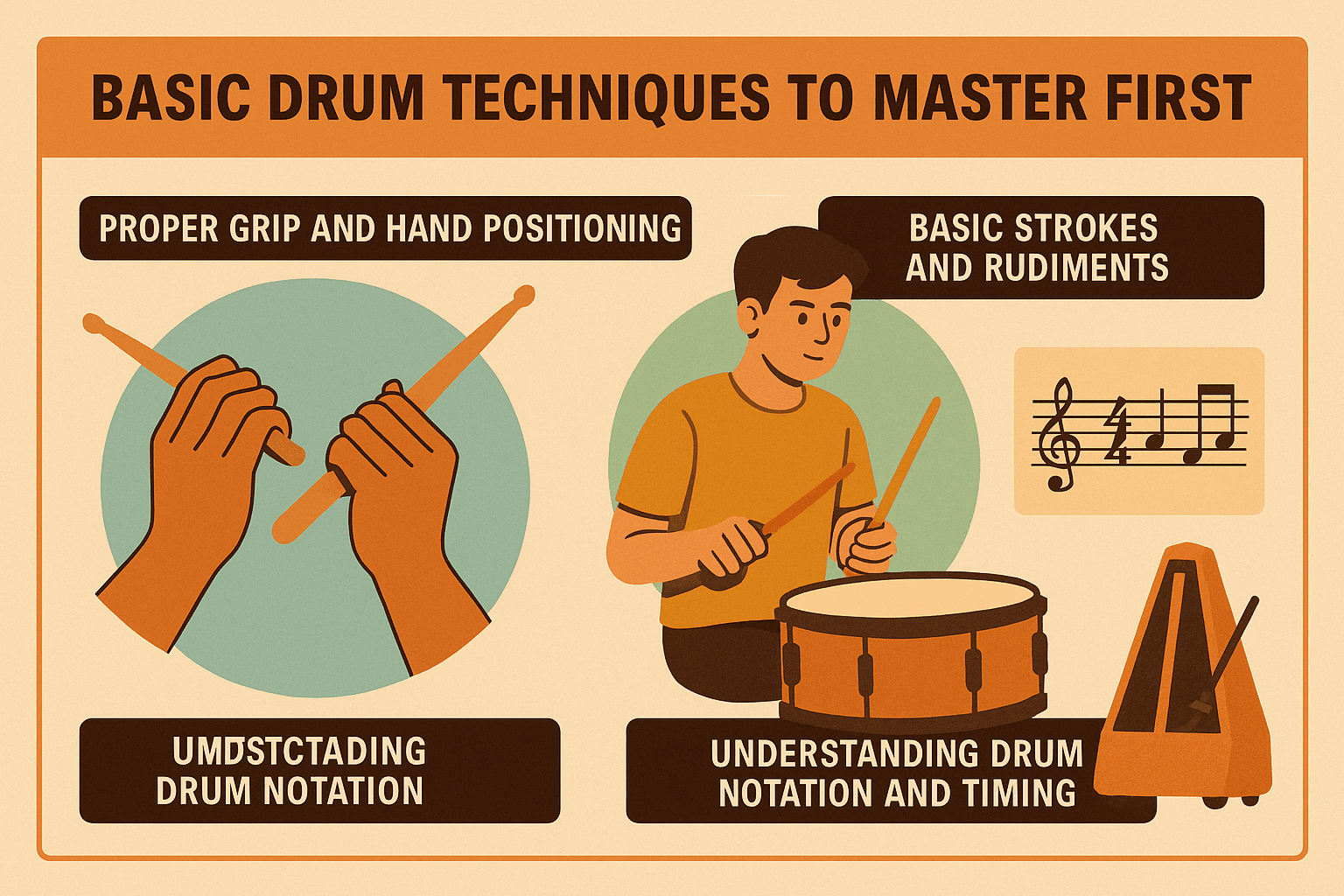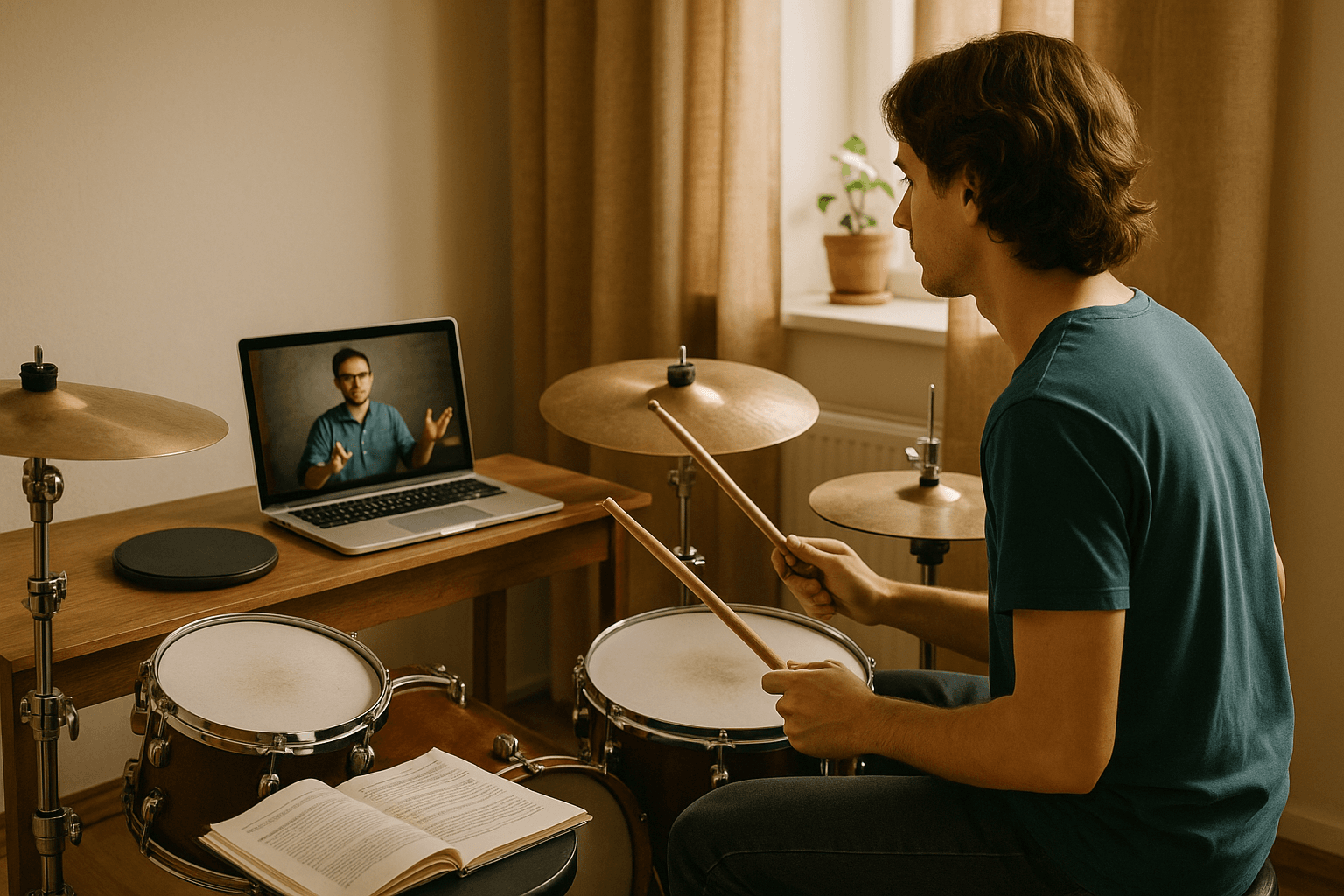
Art Gharana — 12 Mins read
Complete Guitar Strings Guide (Electric & Acoustic)
Musical Instruments

Are you eager to learn to play drums but don’t know where to start? Whether you’ve always dreamed of mastering the drum kit or are curious about taking your first drum lesson, starting on the right foot can make all the difference. Beginning drum lessons can feel overwhelming at first—with so many techniques, rhythms, and drum setups to explore—but with the right guidance, anyone can build confidence and enjoy the learning process.
In this guide, we’ll walk you through essential tips for beginner drum lessons, from choosing the perfect drum kit to developing a consistent practice routine. You’ll discover how to start drum lessons effectively, avoid common beginner mistakes, and develop a strong sense of rhythm and timing. By the end, you’ll feel ready to take on drum tutorials for beginners and set yourself up for success on your drumming journey.
Are you ready to turn your passion for drumming into real skills? Let’s dive in and explore the world of drums, one beat at a time.
 Starting your drumming journey begins with a critical first step: choosing the right drum kit. Have you ever walked into a music store feeling overwhelmed by the rows of drums, cymbals, and electronic kits? You’re not alone. Picking a kit that suits your needs, space, and budget can make your first drum lesson far more enjoyable—and set you up for long-term success.
Starting your drumming journey begins with a critical first step: choosing the right drum kit. Have you ever walked into a music store feeling overwhelmed by the rows of drums, cymbals, and electronic kits? You’re not alone. Picking a kit that suits your needs, space, and budget can make your first drum lesson far more enjoyable—and set you up for long-term success.
When it comes to beginner drummers, the choice between acoustic and electronic kits is a common dilemma.
Worried about the cost? Don’t be. You don’t need a professional-grade kit to start. Many drum courses for beginners recommend starter kits that are affordable yet durable. Investing in a quality entry-level kit ensures you can learn to play drums comfortably without frustration.
Beyond the kit itself, a few key accessories can dramatically improve your practice experience:
Selecting the right drum kit isn’t just about equipment—it’s about setting yourself up for success. If you want expert guidance to find the perfect kit and begin your beginning drum lessons, consider booking a session with an online drum teacher. Starting with the right tools can make your learning journey smoother, more enjoyable, and far more rewarding.
 Have you ever felt frustrated trying to practice drums in a cramped or noisy area? The truth is, where and how you practice can have a huge impact on your progress. Creating a comfortable, organized, and inspiring practice space is just as important as learning your first beats.
Have you ever felt frustrated trying to practice drums in a cramped or noisy area? The truth is, where and how you practice can have a huge impact on your progress. Creating a comfortable, organized, and inspiring practice space is just as important as learning your first beats.
Your body is your instrument, and comfort is key. Here’s how to set up your kit to avoid strain:
If you live in an apartment or shared space, noise can be a challenge. Here’s what to try:
An organized kit promotes better focus and faster progress. Consider these tips:
A well-structured practice space makes every session more productive and enjoyable. If you want expert advice on setting up your drum kit and starting your lessons efficiently, consider checking out Art Gharana’s online drum classes. With the right environment, you’ll find it easier to focus, improve faster, and truly enjoy your beginning drum lessons.
 Have you ever picked up drumsticks and wondered where to start? The foundation of every great drummer lies in mastering the basic drum techniques before diving into complex rhythms. Focusing on fundamentals will make your beginning drum lessons far more productive and enjoyable.
Have you ever picked up drumsticks and wondered where to start? The foundation of every great drummer lies in mastering the basic drum techniques before diving into complex rhythms. Focusing on fundamentals will make your beginning drum lessons far more productive and enjoyable.
Your grip determines control, speed, and endurance. Consider these tips:
Rudiments are the building blocks of drumming. Start with the essentials:
Even if you don’t plan to read sheet music extensively, knowing basic drum notation helps you follow rhythms accurately.
Mastering these core techniques ensures a strong foundation for all future drumming skills. For a structured approach and guided practice, you can explore Art Gharana’s online drum lessons. With the right guidance, you’ll gain confidence, improve quickly, and enjoy every session as you learn to play drums effectively.
 Have you ever wondered why some drummers progress faster than others? The secret isn’t talent—it’s consistency. Developing a practice routine that’s structured, manageable, and motivating is one of the most important steps in your beginning drum lessons journey.
Have you ever wondered why some drummers progress faster than others? The secret isn’t talent—it’s consistency. Developing a practice routine that’s structured, manageable, and motivating is one of the most important steps in your beginning drum lessons journey.
It’s better to practice regularly for short periods than to cram in long sessions sporadically.
Starting each session with warm-ups prepares your hands, wrists, and mind for focused practice:
Setting clear, achievable goals keeps you motivated and provides measurable growth:
Developing a well-rounded practice routine helps you improve faster, stay motivated, and enjoy the learning process. If you want guidance in crafting an effective practice schedule and personalized support, consider booking a trial session with an online drum teacher. With structured practice, learning drums becomes more rewarding and fun.
 Have you ever tapped along to a song and realized your timing was off? One of the most crucial skills for any drummer—especially beginners—is mastering rhythm and timing. Even the most impressive drum fills fall flat if they aren’t played in sync.
Have you ever tapped along to a song and realized your timing was off? One of the most crucial skills for any drummer—especially beginners—is mastering rhythm and timing. Even the most impressive drum fills fall flat if they aren’t played in sync.
Understanding how beats and measures work is fundamental:
A metronome is your best friend as a beginner:
Once you’re comfortable with counting and basic patterns, try playing along with your favorite tracks:
Developing a strong sense of rhythm and timing transforms your drumming from simple hits to expressive, musical performance. If you want expert guidance to learn to play drums online and improve your timing, explore Art Gharana’s online drum lessons. With structured practice and the right tools, you’ll soon feel confident keeping time with any song.
 Have you ever felt frustrated after practicing for hours but not seeing progress? As a beginner, it’s easy to make mistakes that slow down your learning. Recognizing these pitfalls early can save you time and help you enjoy your drum lessons more.
Have you ever felt frustrated after practicing for hours but not seeing progress? As a beginner, it’s easy to make mistakes that slow down your learning. Recognizing these pitfalls early can save you time and help you enjoy your drum lessons more.
It’s tempting to jump straight into flashy drum fills, but skipping the basics can hinder growth:
Sitting incorrectly or setting your kit poorly can create tension and fatigue:
Progressing too quickly can lead to frustration and sloppy technique:
Avoiding these common mistakes helps you build a solid foundation for long-term success. If you want personalized guidance to start drum lessons the right way, consider booking a session with an online drum teacher. Learning from experts ensures you develop correct habits, improve faster, and enjoy every beat you play.
Feeling stuck or unsure where to go next is completely normal when you’re starting out. One of the fastest ways to improve your drumming skills is to seek guidance and utilize the right resources. With so many options available, knowing where to focus your energy can make a big difference.
A skilled teacher can help you avoid common mistakes, develop proper technique, and keep your motivation high:
Supplement your lessons with resources that reinforce what you learn:
Being part of a community can motivate and inspire you:
If you’re ready to take your drumming journey seriously, consider signing up for Art Gharana’s online drum lessons or booking a personalized trial class. With the right guidance, tools, and community support, you’ll not only learn drums online effectively but also enjoy every beat you play.
Embarking on your drumming journey can feel both exciting and overwhelming—but remember, every expert drummer started exactly where you are now. Have you thought about what your first drum lesson will be like? With the right guidance, consistent practice, and a solid understanding of fundamentals, you can turn that excitement into real progress.
By choosing the right drum kit, setting up a comfortable practice space, mastering basic techniques, and developing a structured routine, you’re already laying the foundation for success. Paying attention to rhythm and timing, avoiding common beginner mistakes, and seeking guidance from experienced instructors ensures your learning stays efficient, enjoyable, and rewarding.
If you’re ready to take the next step and learn drums online, consider exploring Art Gharana’s online drum lessons or booking a personalized trial class. Imagine the confidence you’ll feel when you play your first song flawlessly, or the pride of mastering a challenging drum fill. Every beat you practice brings you closer to becoming the drummer you’ve always wanted to be.
So, are you ready to pick up your sticks, start your beginning drum lessons, and make your rhythm come alive? The world of drumming is waiting for you—and your journey starts today.